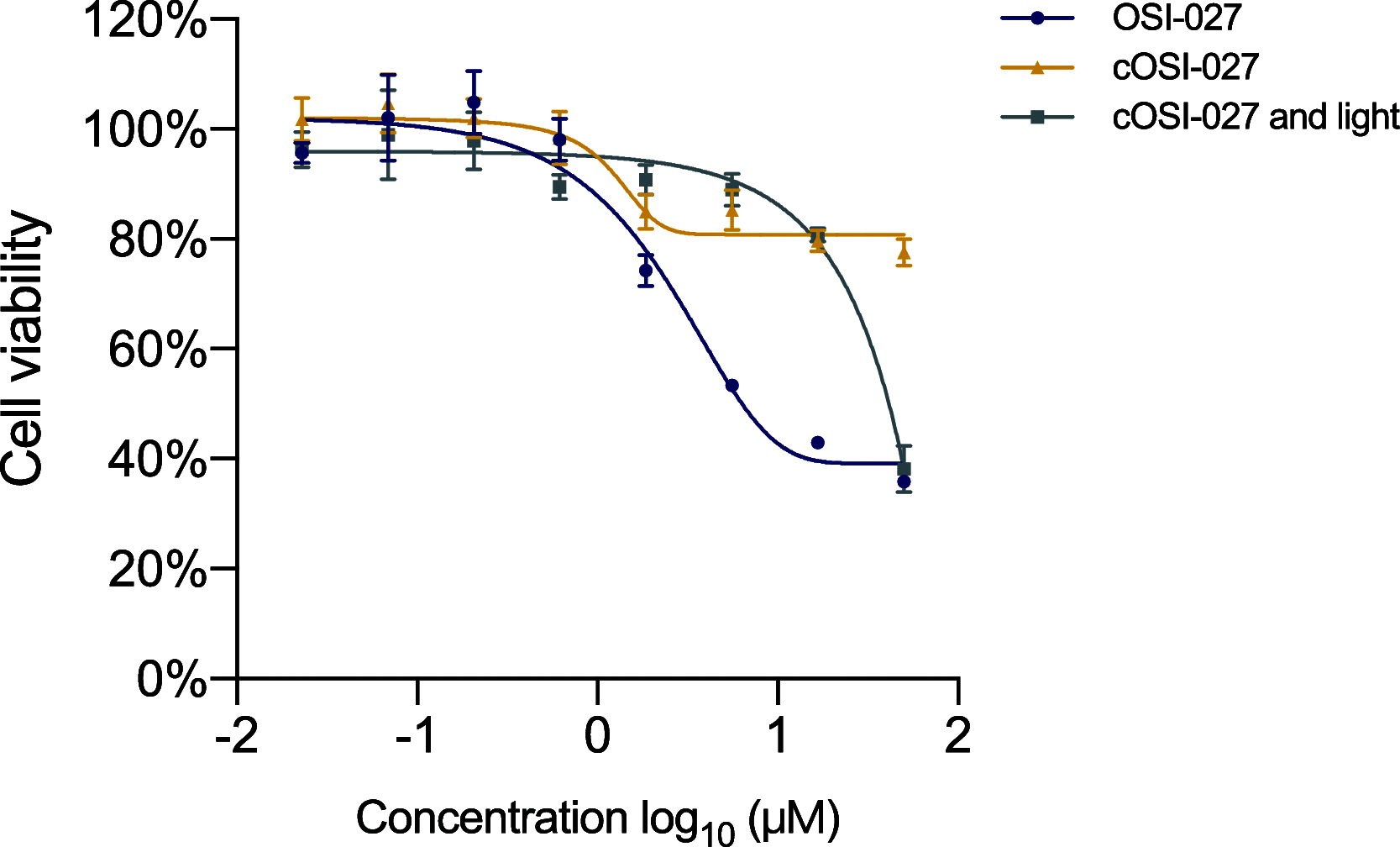Optochemical Control of mTOR Signaling and mTOR-Dependent Autophagy
- PMID: 35311017
- PMCID: PMC8922298
- DOI: 10.1021/acsptsci.1c00230
Optochemical Control of mTOR Signaling and mTOR-Dependent Autophagy
Erratum in
-
Correction to "Optochemical Control of mTOR Signaling and mTOR-Dependent Autophagy".ACS Pharmacol Transl Sci. 2024 Dec 17;8(1):270. doi: 10.1021/acsptsci.4c00714. eCollection 2025 Jan 10. ACS Pharmacol Transl Sci. 2024. PMID: 39816801 Free PMC article.
Abstract
As an important regulator of cell metabolism, proliferation, and survival, mTOR (mammalian target of rapamycin) signaling provides both a potential target for cancer treatment and a research tool for investigation of cell metabolism. One inhibitor for both mTORC1 and mTORC2 pathways, OSI-027, exhibited robust anticancer efficacy but induced side effects. Herein, we designed a photoactivatable OSI-027 prodrug, which allowed the release of OSI-027 after light irradiation to inhibit the mTOR signaling pathway, triggering autophagy and leading to cell death. This photoactivatable prodrug can provide novel strategies for mTOR-targeting cancer therapy and act as a new tool for investigating mTOR signaling and its related biological processes.
© 2022 American Chemical Society.
Conflict of interest statement
The authors declare the following competing financial interest(s): A US provisional patent application was filed with No. 63/215,814.
Figures





Similar articles
-
Preclinical characterization of OSI-027, a potent and selective inhibitor of mTORC1 and mTORC2: distinct from rapamycin.Mol Cancer Ther. 2011 Aug;10(8):1394-406. doi: 10.1158/1535-7163.MCT-10-1099. Epub 2011 Jun 14. Mol Cancer Ther. 2011. PMID: 21673091
-
Inhibition of tumor cell growth, proliferation and migration by X-387, a novel active-site inhibitor of mTOR.Biochem Pharmacol. 2012 May 1;83(9):1183-94. doi: 10.1016/j.bcp.2012.01.019. Epub 2012 Jan 26. Biochem Pharmacol. 2012. PMID: 22305748
-
Targeting mTORC1/2 with OSI-027 inhibits proliferation and migration of keloid keratinocytes.Exp Dermatol. 2019 Mar;28(3):270-275. doi: 10.1111/exd.13882. Epub 2019 Feb 12. Exp Dermatol. 2019. PMID: 30650200
-
Disentangling the signaling pathways of mTOR complexes, mTORC1 and mTORC2, as a therapeutic target in glioblastoma.Adv Biol Regul. 2022 Jan;83:100854. doi: 10.1016/j.jbior.2021.100854. Epub 2021 Dec 6. Adv Biol Regul. 2022. PMID: 34996736 Review.
-
Mammalian target of rapamycin inhibition in hepatocellular carcinoma.World J Hepatol. 2014 Nov 27;6(11):776-82. doi: 10.4254/wjh.v6.i11.776. World J Hepatol. 2014. PMID: 25429315 Free PMC article. Review.
Cited by
-
Integrating mTOR Inhibition and Photodynamic Therapy Based on Carrier-Free Nanodrugs for Breast Cancer Immunotherapy.Adv Healthc Mater. 2024 Dec;13(31):e2402357. doi: 10.1002/adhm.202402357. Epub 2024 Sep 5. Adv Healthc Mater. 2024. PMID: 39235716 Free PMC article.
-
Amino Acid-Starved Cancer Cells Utilize Macropinocytosis and Ubiquitin-Proteasome System for Nutrient Acquisition.Adv Sci (Weinh). 2024 Jan;11(1):e2304791. doi: 10.1002/advs.202304791. Epub 2023 Nov 20. Adv Sci (Weinh). 2024. PMID: 37983609 Free PMC article.
-
Opto-Epigenetic Regulation of Histone Arginine Asymmetric Dimethylation via Type I Protein Arginine Methyltransferase Inhibition.J Med Chem. 2025 Feb 27;68(4):4373-4381. doi: 10.1021/acs.jmedchem.4c02199. Epub 2025 Feb 17. J Med Chem. 2025. PMID: 39961800 Free PMC article.
-
Near-infrared light-triggered prodrug photolysis by one-step energy transfer.Nat Commun. 2023 Dec 7;14(1):8112. doi: 10.1038/s41467-023-43805-y. Nat Commun. 2023. PMID: 38062051 Free PMC article.
References
-
- Samuels Y.; Wang Z.; Bardelli A.; Silliman N.; Ptak J.; Szabo S.; Yan H.; Gazdar A.; Powell S. M.; Riggins G. J.; Willson J. K. V.; Markowitz S.; Kinzler K. W.; Vogelstein B.; Velculescu V. E. High Frequency of Mutations of the PIK3CA Gene in Human Cancers. Science 2004, 304, 554.10.1126/science.1096502. - DOI - PubMed
-
- Sarbassov D. D.; Ali S. M.; Kim D.-H.; Guertin D. A.; Latek R. R.; Erdjument-Bromage H.; Tempst P.; Sabatini D. M. Rictor, a Novel Binding Partner of mTOR, Defines a Rapamycin-Insensitive and Raptor-Independent Pathway that Regulates the Cytoskeleton. Curr. Biol. 2004, 14, 1296–1302. 10.1016/j.cub.2004.06.054. - DOI - PubMed
LinkOut - more resources
Full Text Sources
Research Materials
Miscellaneous
